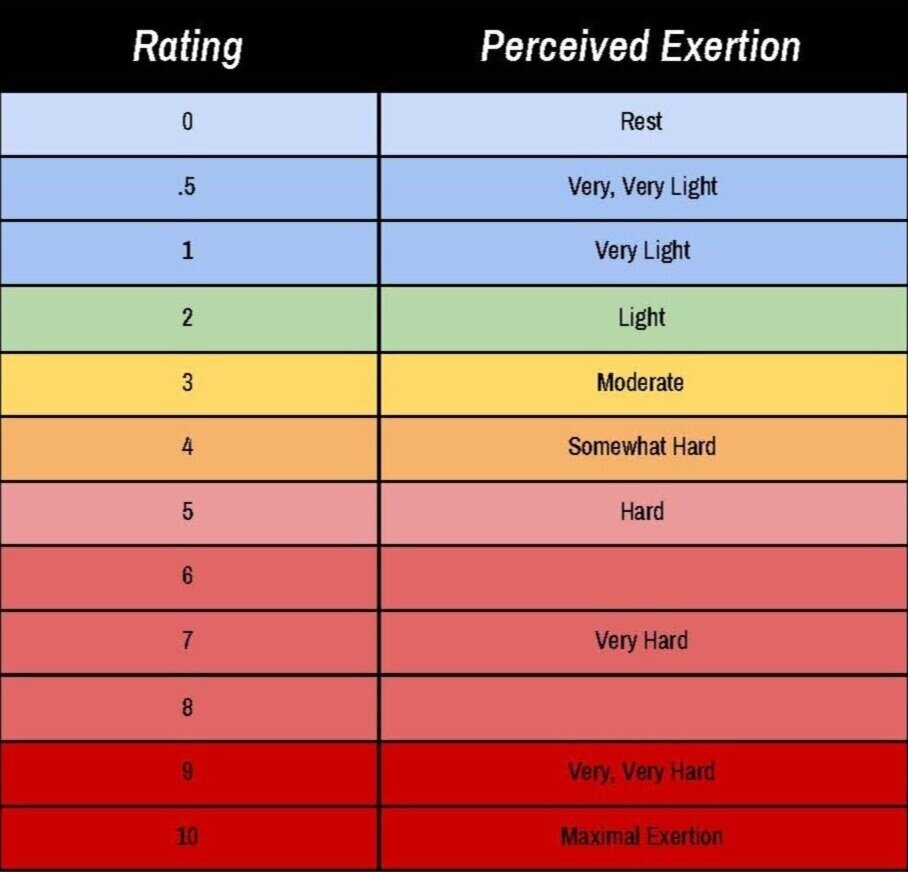Rate Of Perceived exertion for endurance training
RPE is exactly what it sounds like; it is how hard you perceive your body to be pushing itself in a given moment. This scale is also known as the Borg Rating of Perceived Exertion Scale because it was developed by the Swedish scientist Gunnar Borg and is considered the gold standard in RPE-based training. The scale ranges from 6 (no activity) to 20 (all-out maximal effort) with the idea being that you can multiply your RPE by 10 to estimate your heart rate.
(Borg, 1982)
While the heart rate aspect of this scale can be inaccurate depending on the person, starting to put a number to a feeling has tremendous potential during training. I typically recommend the Modified Borg Scale shown below because it is easier to qualify in the moment.
(Borg, 1998)
RPE based training is very useful when you are first starting out as an endurance athlete. Learning to listen to your body is a great skill to have and you will always use it, even when you transition to heart rate and/or power-based training. Experienced athletes who exclusively train with heart rate and/or power should still use RPE to help guide workouts, especially those that seem overly difficult for no apparent reason. An example of this would be if you are beginning a workout that you have completed many times in the past without issue, but suddenly find yourself struggling to maintain your target zone, listen to your body and shut things down. Just because you can, doesn't mean you should and RPE is your body’s way of telling you when enough is enough. In many over-training instances, an athlete’s body sends them signals that something isn’t right long before it is too late. The problem many of these athletes run into is that they are trying to hit a specific pace, heart rate, or power number for a given workout and disregard what their body is telling them. The best way to get reliable RPE data is to track your efforts overtime, and track how you felt before, during, and after specific workouts. Each time you repeat a workout, compare it to the previous session and see if your ranking falls within 1-2 points +/- of the previous rating. If it does, then you have good estimation of your perceived effort for that workout. As you collect more data, you can fine tune your efforts and get even more precise.
Unfortunately, this type of training does have its drawbacks. RPE is highly variable and influenced by a host of factors. A 5 mile training run completed at 6 am on a warm spring day will probably feel very different than if completed at 3 pm in the afternoon on a hot, humid summer day. The hot and humid weather will add to your fatigue and cause you to slow down if you want to keep your perceived effort in check. This makes training for a specific goal difficult if you only use RPE. Knowing when you should pay attention to RPE and when to ignore it takes experience and potentially requires more commitment to heart rate and/or power zone training. Overall, rate of perceived exertion is a great way to start quantifying your training, especially if you are new to endurance sports. Try rating your next few workouts and see where they fall on the RPE scale. You might be surprised!
Pros
Immediate feedback
Easy to assess
Hard to overtrain
Free!
Cons
Subjective
Inaccurate
Highly influential
Can be difficult to compare


